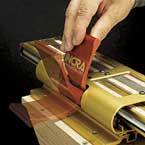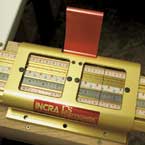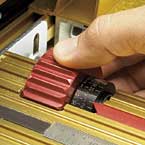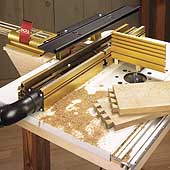|
|
| Issue #281 -February
2004 |
| Incra LS17 Router Table
Fence |
Prior to working on
this article, I knew Incra’s products only by reputation. This
was my opportunity to find out if the three beliefs I held about the
Incra fence (very accurate, very expensive, very complicated) were
at all correct.
After spending a considerable amount of time with the LS17 Super System,
I decided I was wrong on two of the three counts. Turns out that this
fence is |
|
incredibly accurate, but it’s not terribly expensive nor is
it all that complicated.
Don’t get me wrong, you’ll have to shell out about $450
for the system shown here. So it’s no small investment. But
when you compare that cost to the combined cost of a great router
table fence, a great box joint jig, and a great dovetail jig —
all of which the Incra is — the price of this single system
seems quite reasonable.
As for being complicated, it’s more accurate to think of the
Incra as complex. There’s a lot here to learn and understand.
But the manual that comes with the system does an outstanding job
of communicating the intricacies of this system in plain, easy-to-follow
steps. And once you understand it, well, you understand it.
Understanding It
At the heart of this system is the positioner.
This is where most of the adjustments and fine-tuning are done. The
three-position lever toggles the positioner between gross adjustment
(lever all the way down), fine adjustment (lever in the middle position),
and locked (lever all the way up) (Fig. 1).
By looking through the window in the top of the positioner, you can
align the fence on the appropriate scale to within 1/32" (Fig.
2). But if that’s not quite fine enough, you can use the micro-adjustment
knob to fine-tune the fence in .001" increments (Fig. 3). |
 |
 |
| FIGURE
1 - The three-position lever allows you to select from
gross or fine adjustments, or locked. |
|
 |
| FIGURE
2 - Interchangeable scales are marked for specific joint
types and sizes. The steel rule slides in its slot to allow
the fence to be “zeroed” out. |
|
 |
| FIGURE
3 - A micro-adjustment knob and “zero-able”
scale allow for adjustments as fine as .001". |
|
 |
The scales are another important
part of this system. The steel rule is a constant and serves for most
basic positioning. For more involved operations, such as box joints
or dovetail joints, the plastic scales are replaceable. A large assortment
of these scales comes with the Incra, and each one is marked for a
specific size and type of joint.
Of course, every other function and operation of this fence is equally
precise. For instance, adjusting the outfeed face for jointing is
done by sliding it along a wedge that allows for an offset as small
as .002".
Other standard equipment with the LS17 is a right-angle fixture and
a micro-adjustable stop block. Both of these are essential to box
and dovetail joinery, but they have a variety of other uses as well.
I should point out that mounting this system on most tables will require
some type of auxiliary platform. But for all this system does, the
extra effort pays off in spades.
And in truth, I’ve run out of space well short of lauding all
that this system is capable of. It will have to suffice for me to
name it our Editor’s Choice and assure you that it’s worth
every dime. |
 |
|
|





